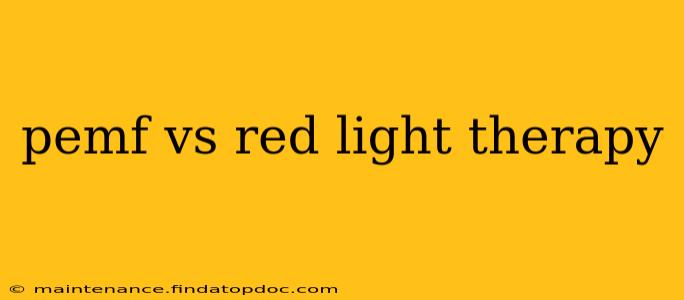Pulsed electromagnetic field (PEMF) therapy and red light therapy (RLT) are both gaining popularity as alternative therapies for a variety of health concerns. Both claim to promote cellular regeneration and healing, but they work through entirely different mechanisms. Understanding these differences is key to determining which therapy, if either, might be beneficial for you. This article will explore the science behind each therapy, comparing their applications, benefits, and potential drawbacks to help you make an informed decision.
What is Pulsed Electromagnetic Field (PEMF) Therapy?
PEMF therapy uses electromagnetic fields to stimulate cells and tissues. Devices emit low-level pulses of electromagnetic energy that penetrate the body, influencing cellular function at a fundamental level. Proponents suggest this stimulation can reduce inflammation, improve blood circulation, and accelerate healing. The pulsed nature of the electromagnetic field is crucial, differentiating it from the static magnetic fields found in, for example, MRI machines.
How Does PEMF Therapy Work?
PEMF therapy is believed to work by influencing the electrical activity within cells. Cells communicate via electrical signals, and PEMF pulses are thought to help restore healthy cellular communication, leading to improved cellular function and repair. This, in turn, may lead to a range of therapeutic effects, which we'll explore further below.
What is Red Light Therapy (RLT)?
Red light therapy, also known as low-level laser therapy (LLLT), uses red and near-infrared (NIR) light to stimulate cells. Unlike PEMF, RLT works by delivering specific wavelengths of light that penetrate the skin and interact with mitochondria – the powerhouses of our cells. This interaction is believed to boost cellular energy production (ATP), reduce inflammation, and promote tissue repair.
How Does Red Light Therapy Work?
The light from RLT is absorbed by photoreceptors within the mitochondria. This absorption triggers a cascade of cellular events, leading to increased ATP production, reduced oxidative stress, and improved cellular function. Different wavelengths of light are believed to penetrate to different depths, affecting various tissues and conditions.
PEMF vs. Red Light Therapy: Key Differences
The most significant difference between PEMF and RLT lies in their mechanisms of action. PEMF uses electromagnetic fields, while RLT uses light. This difference leads to variations in their applications and potential benefits.
| Feature | PEMF Therapy | Red Light Therapy |
|---|---|---|
| Mechanism | Electromagnetic field stimulation | Light absorption by mitochondria |
| Application | Whole body or localized treatment | Localized treatment (skin penetration) |
| Depth of Penetration | Deeper penetration than RLT | More superficial penetration than PEMF |
| Treatment Time | Sessions can last from 20-60 minutes, often daily | Sessions are generally shorter (5-30 minutes) |
What are the Benefits of PEMF Therapy?
PEMF therapy is often associated with:
- Pain relief: Many users report reduced pain from various sources, including arthritis and back pain.
- Improved sleep: The calming effect can lead to better sleep quality.
- Reduced inflammation: This can be beneficial for a wide range of inflammatory conditions.
- Faster wound healing: Improved circulation and cellular function may accelerate healing.
What are the Benefits of Red Light Therapy?
RLT is frequently used to address:
- Skin rejuvenation: Reduction of wrinkles, improved skin texture and tone.
- Wound healing: Similar to PEMF, it may accelerate wound closure.
- Pain relief: Particularly effective for localized pain, such as muscle soreness.
- Hair growth stimulation: Some studies suggest potential benefits for hair loss.
Which Therapy is Better?
There's no single "better" therapy. The optimal choice depends entirely on your individual needs and health concerns. Some individuals may find benefits from both therapies. For example, PEMF might address systemic inflammation, while RLT could target localized skin concerns. It's always best to consult with a healthcare professional before starting any new therapy, especially if you have pre-existing medical conditions.
Can I use PEMF and Red Light Therapy Together?
Yes, there is no known contraindication to using both PEMF and RLT concurrently. Some users report synergistic benefits from combining the two therapies, although more research is needed to confirm these effects. However, always consult with a healthcare professional before combining treatments.
Is PEMF Therapy Safe? Is Red Light Therapy Safe?
Both PEMF and RLT are generally considered safe when administered correctly. However, there are potential risks associated with both, particularly if used improperly or if contraindications are ignored. Pacemakers and other implanted medical devices can potentially be affected by PEMF therapy. RLT can potentially cause eye damage if not used with appropriate eye protection. Therefore, always consult with your doctor before undergoing either treatment.
Conclusion
PEMF and RLT offer distinct approaches to cellular stimulation, each with its own set of potential benefits. While both show promise for a range of conditions, their effectiveness can vary greatly among individuals. The best approach is to discuss your specific health concerns with a qualified healthcare professional to determine which therapy, or combination of therapies, is most appropriate for your needs. Remember that these therapies are often considered complementary or alternative treatments and should not replace conventional medical care.
